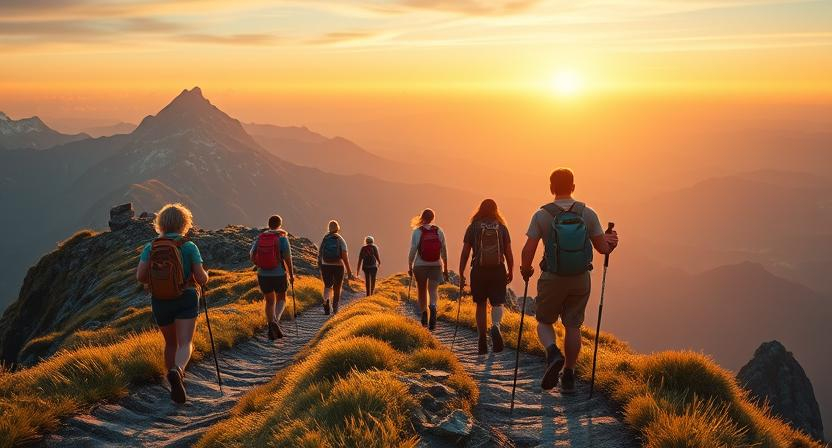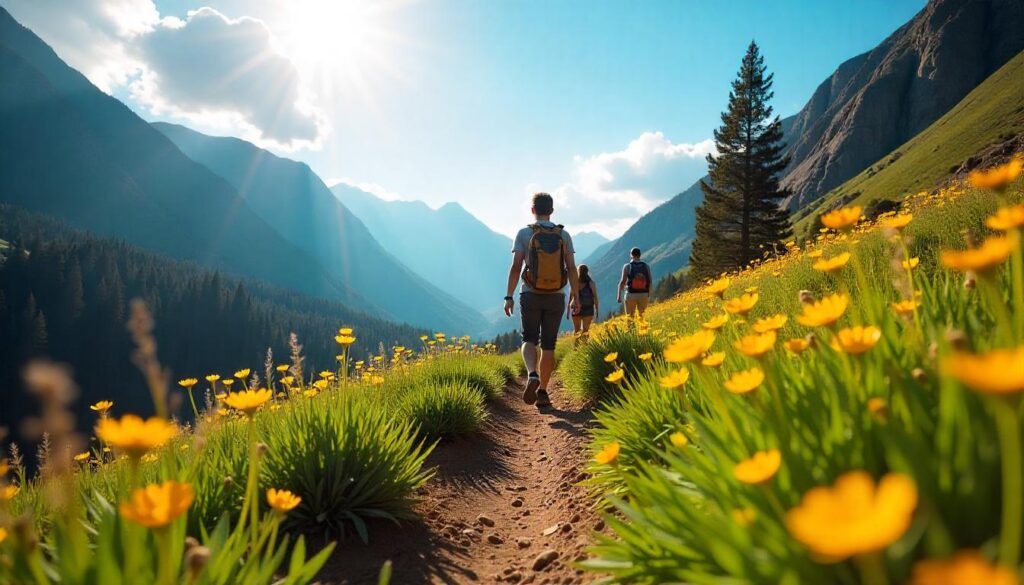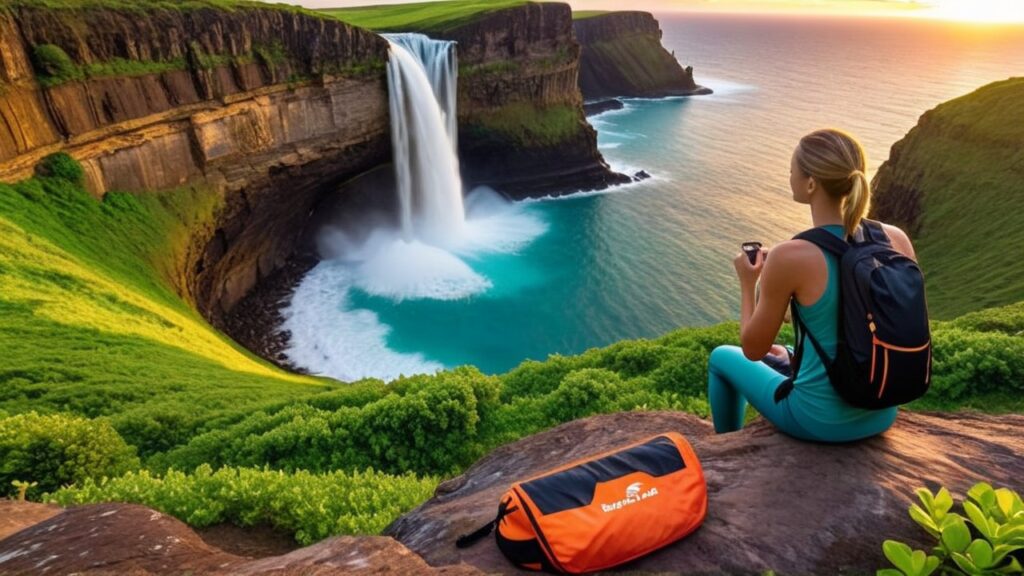
Maui is a hiker’s paradise. From the volcanic moonscape of Haleakalā to the emerald corridors of bamboo forests, Maui hiking trails deliver a feast for all the senses. Whether you’re chasing sunrise on a mountaintop, exploring hidden waterfall canyons or strolling coastal bluffs, this guide will equip you with expert insights, practical tips and itinerary ideas so you can experience the very best hikes in Maui.
Why Hiking in Maui Is Unforgettable
Maui combines dramatic contrasts—towering volcano summits, lush rainforests and wind‑sculpted sea cliffs—into one compact island. Your morning might begin in crisp alpine air above 10,000 ft, then end splashing beneath a tropical waterfall. Few places on earth offer such rapid shifts in climate, scenery and ecosystems.
Local outdoor leaders praise Maui’s trail diversity. “You can hike a lunar landscape at dawn, then by noon be wandering through bamboo groves dripping with mist,” says Lani Kaleo, founder of Hawai‘i Adventure Co. This variety means even seasoned hikers will find fresh surprises on every trail.
Maui’s Unique Terrain: Volcano Summits, Rainforest & Coastal Cliffs
The heart of Maui’s trail system lies in its volcanic backbone. Sliding Sands Trail carves a path down Haleakalā’s crater floor, where wind‑blown cinders stretch like red sand dunes. At higher elevations, silver sword plants cling to fissured lava—an otherworldly sight that rewards pre‑sunrise efforts.
Lower down, Waihe‘e Ridge and Mahana Ridge traverse misty jungles filled with banyan and ‘ōhi‘a trees. Sunbeams filter through dense canopies, illuminating emerald moss on rock walls. In West Maui, coastal trail Maui loops deliver sweeping Pacific panoramas, with blowholes and sea arches visible at Nakalele Point.
This dramatic topography means each hike Maui trail feels completely different—yet they all share one common thrill: a profound sense of discovery and place.
Planning Your Maui Hiking Adventure

Great hikes start with smart planning. Permits, lodging, guided‑tour bookings and weather windows all play a role. By mapping out your trip and packing the right gear, you’ll maximize safety and enjoyment on Maui’s most iconic routes.
Where to Stay in Maui While Hiking
Your basecamp sets the tone for each day’s adventure. In West Maui, beachside resorts in Kaanapali and Kapalua offer luxury and quick access to coastal trail Maui loops at sunrise. For crater‑top treks, book a cottage in Kula or a cabin near Makawao—both are within a 30‑minute drive of Haleakalā summit trailheads.
Budget travelers should consider Kihei or Wailuku. These towns boast affordable inns and vacation rentals, plus easy drives to South Maui hikes like Makena’s hidden ocean coves and Twin Falls rainforest walks. Wherever you stay, aim for under 30 minutes to your morning trailhead to beat crowds and midday heat.
Maui Hiking Tours vs. Self‑Guided Hikes
Guided tours bring insider knowledge and turnkey logistics. Certified guides handle permits, shuttle you to remote trailheads and share local lore—like which seasonal waterfall trail is flowing strongest. Tours are ideal for families, first‑timers and anyone seeking deep cultural context on rainforest and waterfall hikes in Maui.
Self‑guided hikers enjoy total freedom. Download a detailed Maui hiking map, study trail markers, and venture out on your own schedule. Self‑guided journeys work best on well‑maintained routes like Kapalua Coastal Trail, Sliding Sands and Waihe‘e Ridge. Always tell someone your plan and estimated return time, especially for remote treks like Kaupo Gap.
Essential Gear & Safety Tips for Hike Maui Trails
- Sturdy, Waterproof Boots
Mid‑height hiking boots with aggressive tread are a must on rocky volcano scree and slippery jungle floors. Waterproof models keep feet dry during creek crossings on bamboo forest hikes. - Hydration System & Water Filter
Plan on at least 2 liters per person for half‑day hikes; add purification tablets or a compact filter for backcountry routes like Kaupo Gap where refill stations are nonexistent. - Sun Protection & Layered Clothing
UV rays intensify above 6,000 ft. Wear a wide‑brim hat, UV‑blocking sunglasses and SPF 50+ sunscreen. Pack a lightweight windbreaker for summit breezes on Haleakalā and early‑morning coastal chills. - Navigation Tools & Emergency Beacon
A detailed offline map or GPS app helps on less‑marked trails. Cell service is spotty on forested routes; carry a personal locator beacon when venturing into remote canyons. - First‑Aid Kit & High‑Energy Snacks
Include blister pads, antiseptic wipes and pain relievers for minor trail mishaps. Pack trail mix, energy bars and peanut butter sandwiches to maintain stamina on best day hikes in Maui like Sliding Sands and Polipoli.
Before you hit the trails, make sure you’re fully prepared gear wise and apparel wise.
Crafting Your Perfect Maui Hiking Vacations Itinerary
Balance epic and easy to avoid burnout. Begin with a bucket‑list sunrise at Haleakalā, then spend the afternoon on a gentle rainforest or coastal stroll. Dedicate another day to a waterfall trek—Twin Falls or the Road to Hana’s hidden cascades—and slot in a rest day for snorkeling, luaus or beach lounging. End your trip with a sunset hike along Olinda Forest or a breezy Kapalua ridge loop. This mix ensures you experience the full diversity of Maui hiking trails without rushing or fatigue.
Top 10 Best Hikes in Maui that You Should Visit
1. Sliding Sands Trail
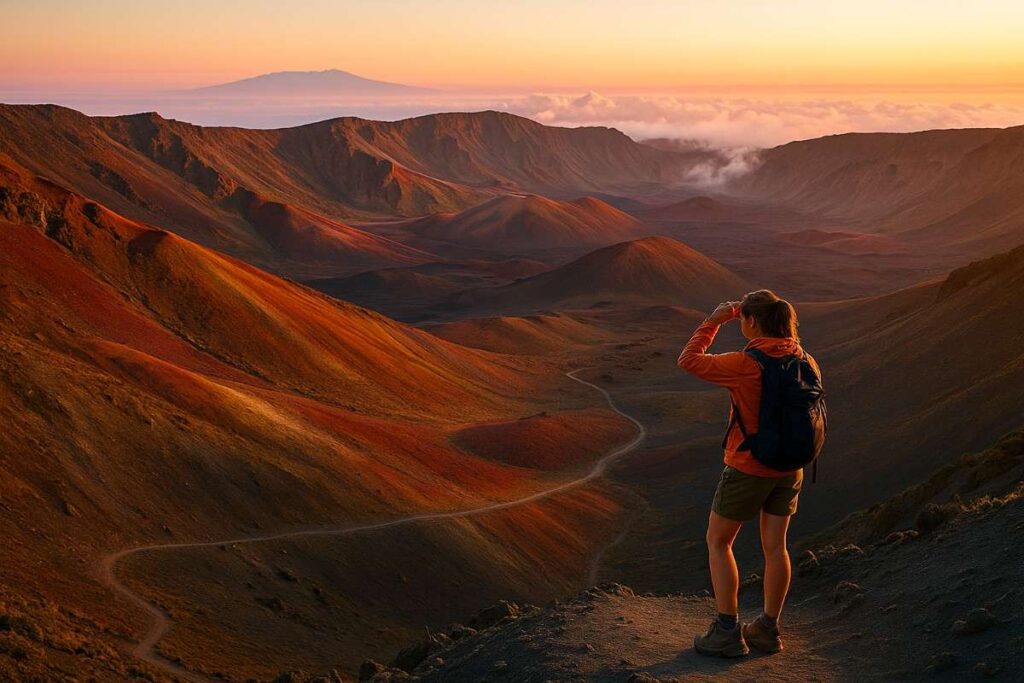
Introduction
Sliding Sands Trail is often called the crown jewel of Maui hiking trails. You’ll descend into Haleakalā’s massive volcanic crater where red and black cinder fields stretch toward the horizon. Early morning light turns the landscape golden, making every step feel otherworldly. The trail gives you a real sense of walking on another planet, with sparse vegetation and sweeping crater walls. Wildlife is minimal, but you may spot the rare nēnē goose or silversword plants clinging to ridges. As an expert guide once told me, the silence inside the crater is both humbling and inspiring—truly one of the best hikes in Maui.
Descending into Haleakalā’s vast volcanic crater feels like stepping onto another planet. As dawn’s first light paints the cinder fields in hues of rose and gold, you’ll notice the delicate silversword plants clinging to the slopes—survivors of centuries. The trail’s steep switchbacks demand focus, yet each bend reveals ever‑more dramatic vistas of crater walls and distant ocean blues. Expert guides often compare this landscape to Iceland’s highlands, but with Hawaii’s signature warmth and gentle trade winds. No two hikes here look the same—morning mists can transform rugged ridges into ethereal valleys in a matter of minutes.
Trail Distance, Elevation, Difficulty, and Permit
- Distance: 11 miles round‑trip
- Elevation Gain: 2,800 ft descent/ascent
- Difficulty: Strenuous (steep, loose cinders)
- Permit: Day‑use permit required for sunrise hikes
Best Time to Visit
Aim for a sunrise start between October and April when temperatures are moderate and the crater view is at its most dramatic. Midweek mornings have fewer crowds.
Personal Tips & Safety Precautions
- Start well before dawn and carry a headlamp to navigate switchbacks in the dark.
- Dress in layers—summit temperatures can be below 40 °F even when it’s warm at the trailhead.
- Pack at least 3 liters of water and high‑energy snacks; there are no refill stations.
- Stay on the marked path to protect fragile silversword plants and avoid loose cinder slides.
2. Iao Needle Hike
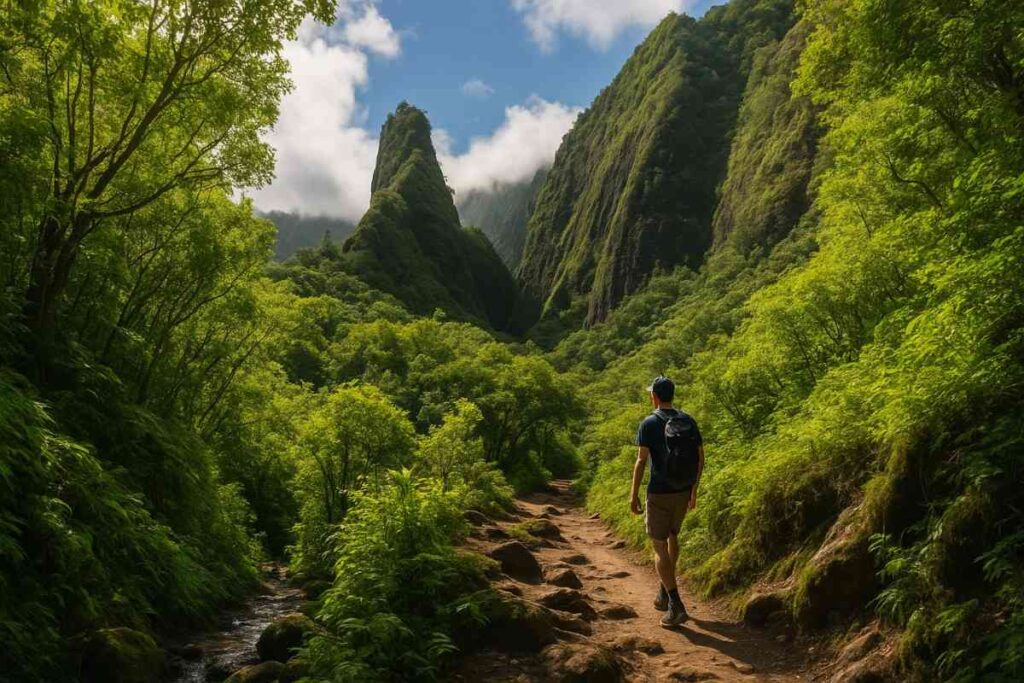
Introduction
The Iao Needle Hike winds through a lush, emerald valley where towering basalt pinnacles pierce the sky. Locals revere this spot for its cultural significance and sacred history. A gentle paved path and wooden walkways make it one of the best beginner hikes in Maui, yet the scenery feels grand. Ferns drape over mossy stones, and small streams trickle beside the trail. At the lookout, the iconic Iao Needle looms 1,200 ft above the valley floor. This easy, family‑friendly hike offers sweeping views without demanding technical skill, making it a must‑do on any Maui hiking vacation.
Framed by verdant valley walls, the needle rises like nature’s cathedral steeple over a carpet of ferns and ‘Ohi‘a trees. Unlike many Maui hiking trails, the paved walkways and sturdy boardwalks invite families and first‑time hikers to explore without technical gear. But don’t let the ease fool you—the serene atmosphere and cascading streams instill a deep sense of place. Visitors often remark on the cool, misty air, a refreshing contrast to Maui’s sun‑bleached beaches.
Trail Distance, Elevation, Difficulty, and Permit
- Distance: 0.6 miles round‑trip
- Elevation: 2500 ft from sea level
- Difficulty: Hard (paved, accessible)
- Permit: Free parking permit at the state park
Best Time to Visit
Morning visits are ideal—before midday heat and afternoon showers, you’ll enjoy dappled sunlight and cooler air.
Personal Tips & Safety Precautions
- Wear sturdy shoes; the paved path can be slippery from mist.
- Bring insect repellent to ward off mosquitoes in the shaded valley.
- Check park hours and arrive early; parking fills quickly on weekends.
- Respect cultural signage and stay within designated areas to honor local heritage.
3. Waihee Ridge Trail

Introduction
Waihee Ridge Trail delivers panoramic views of verdant valleys merging with the Pacific Ocean. As you climb, the jungle canopy gives way to grassy ridges dotted with colorful wildflowers. The trail’s knife‑edged ridge creates exhilarating exposure and breathtaking vistas on both sides. Many hikers consider it one of Maui’s most scenic hikes for its dramatic elevation gain and lush surroundings. Beginner hikers quickly gain confidence as they ascend, rewarded by a viewpoint showing cascading waterfalls far below. Wildlife sightings often include native sugarcane birds and, if you’re lucky, a glimpse of a nene goose pair.
Along the way, 180° lookouts reveal tumbling waterfalls hidden in emerald canyons below. Local birdwatchers share stories of spotting native ‘io hawks, swooping gracefully over the ridge crest. The trail’s mix of jungle canopy and open grasses means you’ll pass through cool shade before emerging onto sunlit ridgelines—each segment offering a new perspective. On clear mornings, the mist retreats to reveal Molokai’s cliffs shimmering in the distance.
Trail Distance, Elevation, Difficulty, and Permit
- Distance: 4 miles round‑trip
- Elevation: 1,500 ft
- Difficulty: Moderate to strenuous (steep switchbacks)
- Permit: No permit required; park at Waihee Ridge parking lot
Best Time to Visit
Plan for a clear weekday morning between April and June for optimal visibility and fewer crowds.
Personal Tips & Safety Precautions
- Pack a windbreaker; ridge winds can be strong and chilly.
- Use trekking poles to steady yourself on uneven switchbacks.
- Carry at least 2 liters of water—no refill point on the trail.
- Watch for muddy sections after rain; waterproof boots improve traction.
4. Kapalua Coastal Trail
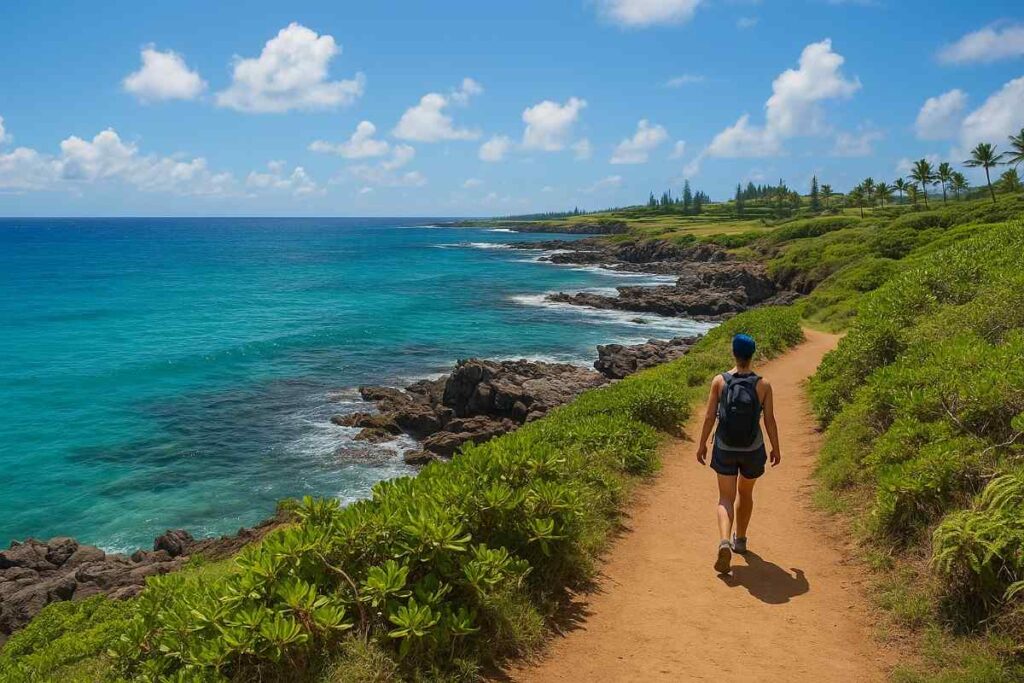
Introduction
The Kapalua Coastal Trail meanders along towering sea cliffs, past secluded bays and sculpted lava formations. This flat, well‑maintained path is perfect for families and runners seeking an easy coastal workout. Fragrant ironwood trees and colorful bougainvillea line parts of the trail, while tide pools teem with marine life. Dramatic blowholes and panoramic ocean views make every turn a photo opportunity. Local guides often point out the seasonal migration of whales visible from shore between December and April. It’s one of the best easy hikes in Maui—accessible, beautiful and brimming with tropical charm.
Winding along lava‑carved cliffs, this seaside promenade showcases Maui’s softer side: sheltered bays, tide pools brimming with marine life and fragrant ironwood groves. Unlike strenuous summit quests, this trail feels like a leisurely island stroll—yet with postcard‑perfect overlooks at every turn. Photographers love the way early sunlight pierces the bougainvillea‑draped trees and lights up the Pacific spray. Local runners favor its smooth path for sunrise workouts, while families linger at hidden coves to watch colorful reef fish. In winter months, whale spouts punctuate the horizon, reminding you that Maui hiking trails offer encounters both on land and sea.
Trail Distance, Elevation, Difficulty, and Permit
- Distance: 3.5 miles out‑and‑back
- Elevation: Minimal (30 ft)
- Difficulty: Easy (paved/gravel)
- Permit: None; parking available at Kapalua Bay
Best Time to Visit
Early morning or late afternoon offers cooler temperatures and softer light for photography.
Personal Tips & Safety Precautions
- Bring binoculars for whale and seabird watching from cliff overlooks.
- Stay back from cliff edges—some areas lack guardrails.
- Wear reef‑safe sunscreen to protect coral ecosystems when exploring tide pools.
- Carry a small towel and water shoes for wading in calm bays.
5. Mahana Ridge Trail
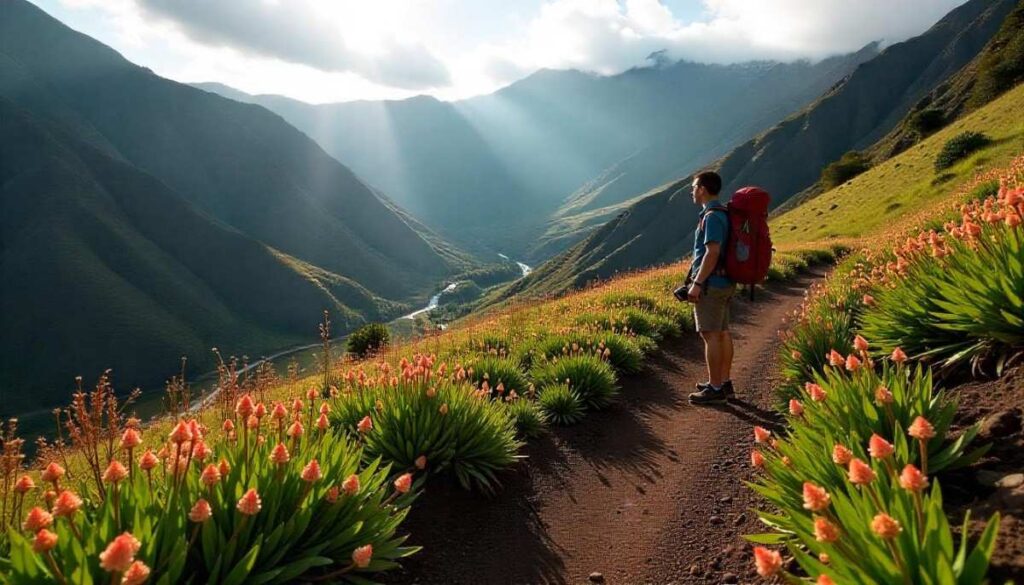
Introduction
Mahana Ridge earns its “Bamboo Forest Hike” nickname from the towering stalks that arch overhead, creating a green cathedral echoing with bird calls. Dappled sunlight filters through the stalks, creating a serene, almost sacred atmosphere. Along the way, you’ll encounter occasional breaks in the canopy where you can glimpse rolling hills and distant ocean views. This moderate trail balances shade and open ridge sections, offering varied scenery. Birdsong fills the air, with sightings of native ‘iwa seabirds occasionally overhead. The trail ends at a scenic overlook that rewards every step with sweeping valley panoramas.
As you press deeper, the air cools and the forest hushes, broken only by the soft rustle of bamboo leaves. Seasonal wildflowers—vibrant reds and yellows—sprinkle the forest floor, a delightful surprise amid the verdant shades. Hikers who time it right will catch clouds drifting through the grove, transforming the setting into a living watercolor. This trail’s blend of sheltered jungle and open ridgeline makes it one of the most photogenic local hikes Maui has to offer.
Trail Distance, Elevation, Difficulty, and Permit
- Distance: 4 miles round‑trip
- Elevation:: 750 ft
- Difficulty: Moderate (steep sections, narrow boardwalks)
- Permit: None; park at Mahana Ridge trailhead
Best Time to Visit
Visit during the dry season (May to September) to avoid muddy boardwalks and slippery bamboo shoots.
Personal Tips & Safety Precautions
- Wear gaiters to keep muddy water and insects out of your boots.
- Bring a camera with a zoom lens for bird photography.
- Use eco‑friendly insect repellent to protect delicate bamboo ecology.
- Stay on boardwalks to prevent erosion and protect fragile undergrowth.
6. Polipoli Trail

Introduction
High above the sugarcane fields of Kula, Polipoli Trail Stadium offers alpine‑like hiking in Hawaii. Pine forests and grassy clearings replace the island’s usual tropical palette, evoking memories of the mainland. The crisp air and whispering pines make you feel a world away from the coast. Seasonal wildflowers burst into color in spring, turning grassy slopes into a quilt of reds and golds. Friendly trail runners and local birdwatchers frequent this area, so you’re never truly alone. Polipoli gives a unique taste of Maui’s high‑elevation ecosystems.
N Many visitors are amazed to find redwood‑like trunks and carpeted forest roads reminiscent of Oregon, yet with Hawaiian vistas peeking between the trees. In spring, lupine and silvery lupin blooms add pops of lavender along the path. Trail runners and birders alike praise Polipoli for its cool, fresh air and crisp, pine‑scented ambiance. Here, maple leaves mingle with guava, reminding you that Maui hiking vacations can surprise you at every turn.
Trail Distance, Elevation, Difficulty, and Permit
- Distance: 5 miles out‑and‑back
- Elevation: 800 ft
- Difficulty: Easy to moderate (well‑graded forest road)
- Permit: No permit required; parking at Polipoli Spring Recreation Area
Best Time to Visit
Cooler months (October to March) are ideal to avoid summer heat, and fall offers stunning wildflower displays.
Personal Tips & Safety Precautions
- Start early to watch mist roll through the pine forests.
- Dress in layers; temperatures can drop quickly at higher altitudes.
- Pack snacks high in protein to sustain energy on rolling terrain.
- Carry a headlamp if you plan a pre‑dawn start for sunrise photography.
7. Nakalele Blowhole & Point
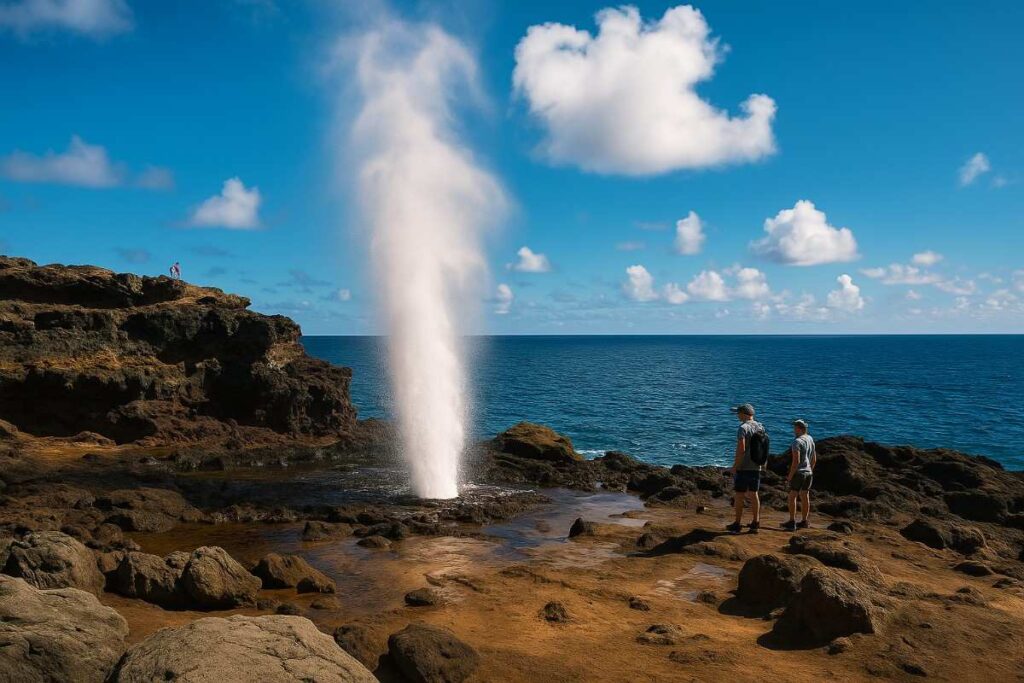
Introduction
Nakalele Blowhole Trail delivers raw coastal energy—waves erupt through volcanic lava tubes, spraying seawater skyward. Rugged lava fields and dramatic cliffs set the stage for this heart‑pounding spectacle. Hikers scramble over jagged rocks to reach the blowhole, feeling the ocean’s power beneath their feet. A nearby natural arch and tide pools add to the area’s wild charm. It’s one of the most adrenaline‑fuelled local hikes Maui offers and a must‑see for adventurous spirits. Just don’t get too close—the blowhole’s pressure can be dangerous.
Here, “coastal trail Maui” takes on dramatic meaning: waves funnel through underground lava tubes and erupt skyward in powerful geysers. The trail follows jagged lava fields, rewarding explorers with a natural lava arch and tide pools teeming with sea stars at low tide. Adventurous hikers feel the ocean spray on their faces as wind and water collide. It’s one of the few Maui hiking trails where the earth’s raw energy is so vividly on display. Experts caution visitors to keep a safe distance, but even from afar, the blowhole’s rhythmic eruptions deliver an unforgettable rush.
Trail Distance, Elevation, Difficulty, and Permit
- Distance: 1.5 miles round‑trip
- Elevation: 100 ft
- Difficulty: Moderate (uneven lava rock, some scrambling)
- Permit: None; roadside parking off the Hana Highway
Best Time to Visit
Mid‑morning at low tide provides safer footing and more dramatic blowhole spouts.
Personal Tips & Safety Precautions
- Wear closed‑toe shoes with excellent grip for lava field navigation.
- Observe from a safe distance—blowhole spray can knock you off balance.
- Check tide charts before you go to avoid unexpected waves.
- Bring a waterproof camera to capture explosive water bursts.
8. Olinda Forest Recreation Loop

Introduction
The Olinda Forest Recreation Loop winds through eucalyptus and koa trees, offering a cool, shaded escape. This moderate loop alternates between smooth forestry roads and single‑track trails. In spring, wildflowers carpet the understory in bursts of purple, pink and yellow. Birdwatchers delight in spotting native ‘i‘iwi and apapane darting through the canopy. The forest floor feels soft underfoot, making this one of Maui’s best easy hikes. For a change of pace, mountain bikers also use these trails, though hikers have the right of way.
Trail Distance, Elevation, Difficulty, and Permit
- Distance: 4 miles loop
- Elevation: 500 ft
- Difficulty: Easy to moderate (packed dirt, minor roots)
- Permit: None; park at Olinda Forest parking area
Best Time to Visit
Early morning visits reveal mist clinging to tree branches and active birdlife.
Personal Tips & Safety Precautions
- Stay on marked trails to protect sensitive understory plants.
- Carry binoculars for canopy birdwatching.
- Pack a light rain jacket; forest microclimates can be damp.
- Respect mountain bike signage and yield when needed.
9. Kaupo Gap Trailhead

Introduction
Kaupo Gap Trailhead offers a remote, off‑the‑beaten‑path trek that rewards solitude seekers. The trail climbs through native grasslands into wintry high‑country zones of Haleakalā forest. Lava‑rock outcrops and hardy naio shrubs dot the landscape. Few hikers venture this far, so you’ll likely have the trail to yourself. At the summit, 360‑degree views of the south shore and Molokini Crater unfurl before you. This is one of Maui’s true wilderness hikes—ideal for experienced adventurers seeking raw, unfiltered nature.
Trail Distance, Elevation, Difficulty, and Permit
- Distance: 7 miles out‑and‑back
- Elevation: 2,000 ft
- Difficulty: Strenuous (steep, remote)
- Permit: No permit required; park at Kaupo Gap road pull‑off
Best Time to Visit
Visit in dry-season months (April to September) to avoid muddy, slippery slopes.
Personal Tips & Safety Precautions
- Tell someone your itinerary—no cell service in this remote area.
- Carry a 406 MHz emergency beacon for backcountry safety.
- Pack extra layers; temperatures can plummet above 6,000 ft.
- Bring a GPS device alongside maps to navigate unmarked segments.
10. Pu’u Olai (Red Hill)
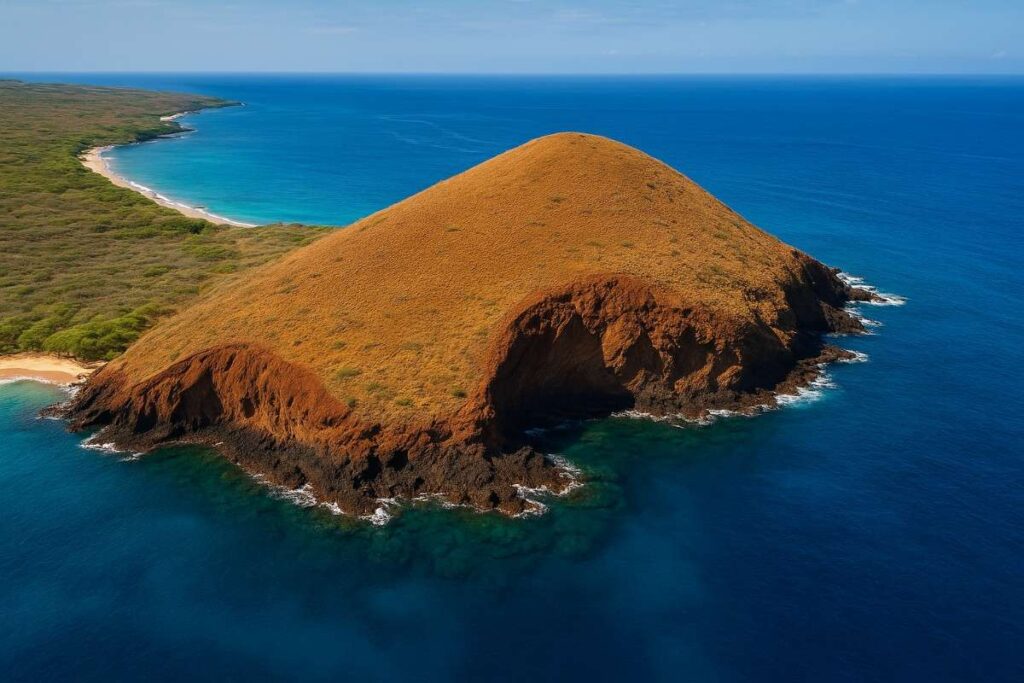
Introduction
Pu’u Olai, known locally as Red Hill, offers sweeping views of Maui’s south shore and Molokini Crater from its crimson summit. The steep switchbacks climb through kiawe and lama trees before opening onto bright red cinder slopes. Sunlight turns the volcanic soil a fiery orange, contrasting with the deep blue Pacific. Hikers often combine this trek with nearby Makena State Park beach visits. It’s a short but exhilarating volcano hike in Maui—perfect for a half‑day adventure with maximum payoff.
Trail Distance, Elevation, Difficulty, and Permit
- Distance: 2 miles round‑trip
- Elevation: 700 ft
- Difficulty: Moderate (steep cinder climb)
- Permit: None; park at Makena State Park
Best Time to Visit
Late morning when sunlight fully illuminates red cinder slopes; crowds are lighter on weekdays.
Personal Tips & Safety Precautions
- Wear a bandana or face mask to filter cinder dust.
- Hike early to avoid midday heat on exposed slopes.
- Carry at least 2 L water—no shade on the cinder ascent.
- Apply waterproof sunscreen; volcanic soil reflects UV rays intensely.
Quick Comparison: Top 10 Best Hikes in Maui
| Trail Name | Distance | Elevation Gain | Difficulty | Season | Permit Required |
|---|---|---|---|---|---|
| Sliding Sands Trail | 11 miles round trip | 2,800 ft | ⭐️⭐️⭐️⭐️ Moderate to Hard | Summer & Early Fall | Yes (Haleakalā NP) |
| Iao Needle Hike | 0.6 miles round trip | 200 ft | ⭐️⭐️ Easy | Year-round | Entry Fee Required |
| Waihee Ridge Trail | 4.2 miles round trip | 1,500 ft | ⭐️⭐️⭐️⭐️ Moderate to Hard | Spring to Fall | No |
| Kapalua Coastal Trail | 1.76 miles one way | 150 ft | ⭐️⭐️ Easy | Year-round | No |
| Mahana Ridge Trail | 10 miles round trip | 2,000 ft | ⭐️⭐️⭐️⭐️☆ Hard | Winter to Spring | No |
| Polipoli Trail | 3.5 miles loop | 1,200 ft | ⭐️⭐️⭐️⭐️ Moderate to Hard | Summer & Early Fall | No |
| Nakalele Blowhole & Point | 1.2 miles round trip | 200 ft | ⭐️⭐️ Easy | Year-round | No |
| Olinda Forest Recreation Loop | 2.0 miles loop | 400 ft | ⭐️⭐️⭐️ Moderate | Year-round | No |
| Kaupo Gap Trailhead | 8.0+ miles one way | 5,000 ft | ⭐️⭐️⭐️⭐️⭐️ Very Hard | Dry Season (May–Sept) | Yes (Haleakalā NP) |
| Pu’u Olai (Red Hill) | 1.5 miles round trip | 350 ft | ⭐️⭐️⭐️ Moderate | Year-round | No |
Best Hikes in Maui by Category
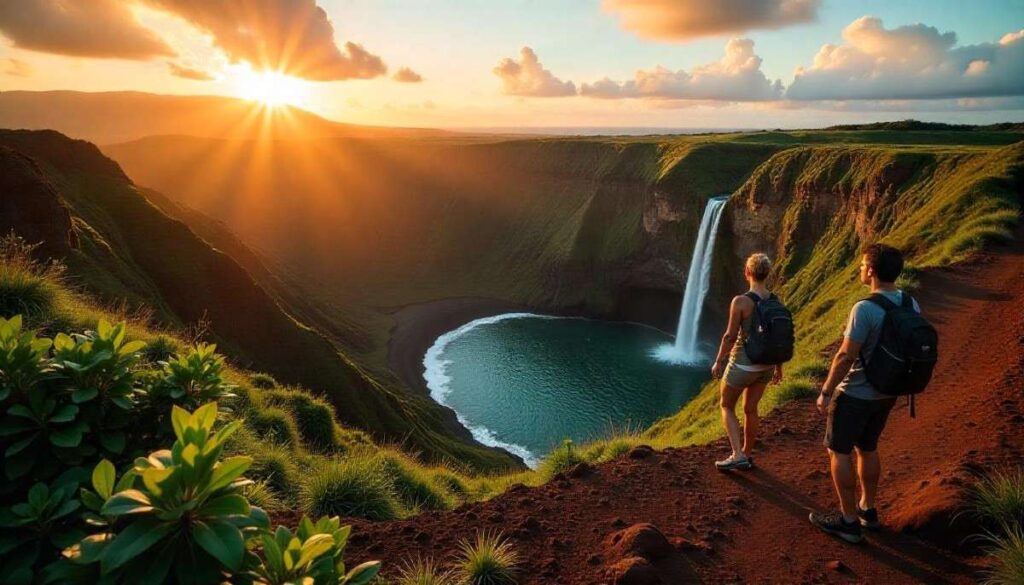
Best Day Hikes in Maui for Quick Adventures
If you’re short on time but still want a taste of Maui hiking trails, choose one of these day‑trip favorites. The Kapalua Coastal Trail delivers three miles of family‑friendly seaside views and tide pools, perfect for a morning jaunt. For a volcano‑style taste, the Pu’u Olai (Red Hill) hike rewards you with fiery cinder slopes and ocean panoramas in just two hours. And if you crave lush jungle scenery, the Iao Needle Hike offers a gentle half‑mile loop through emerald valleys, making it one of the best day hikes in Maui. Each trail pairs neatly with a beach picnic or afternoon snorkeling session.
Best Sunrise Hikes in Maui: Top Vantage Points
Chasing dawn light on Maui is an experience you won’t forget. Nothing tops the summit of Haleakalā—the Sliding Sands Trail’s ridge offers 360° views of a sun‑soaked crater. For a coastal sunrise, head to the Kapalua Coastal Trail and watch golden rays dance on the Pacific. Or hike Pu’u Olai early to see the red cinder slopes glow under first light. These are the best sunrise hikes in Maui, blending cooler pre‑dawn air with epic views that feel tailor‑made for your first coffee.
Best Sunset Hikes in Maui: Golden‑Hour Trails
When the day winds down, Maui’s trails take on a magical glow. The Makawao Forest Loop (Polipoli Trail) sits high above the island, offering sweeping sunset vistas through tall pines. For oceanfront drama, the Nakalele Blowhole & Point trail lets you feel the spray as the sun dips below the horizon. Another top pick is the Kapalua Coastal Trail, where palm‑lined coves and rugged lava cliffs shimmer in fiery gold. These best sunset hikes in Maui turn evening adventures into unforgettable photo ops.
Best Waterfall Hikes in Maui & Rainforest Treks
Maui’s waterfall hikes immerse you in verdant rainforest cathedrals. The iconic Twin Falls on the Road to Hana is a family‑friendly trek with multiple cascades and swimming holes. For a longer rainforest adventure, the Mahana Ridge Trail—aka Bamboo Forest Hike—leads you through towering bamboo and hidden falls. Closer to central Maui, Waiheʻe Ridge Trail hides misty tributaries feeding remote waterfalls. These best waterfall hikes in Maui blend Pacific humidity with tropical blooms, creating a true rainforest hike Maui enthusiasts crave.
Best Family Hikes in Maui & Kid‑Friendly Hikes in Maui
Planning a multigenerational outing? Ease into Maui’s trails with Iao Needle and the gentle Olinda Forest Recreation Loop—both offer smooth paths, interpretive signs and minimal elevation change. The Kapalua Coastal Trail is stroller‑friendly, with tide pools that delight young explorers. For a bit more adventure, try the Bamboo Forest Hike on Mahana Ridge, where boardwalks guide you through bamboo “cathedrals.” These best family hikes in Maui ensure safety and wonder for hikers of all ages.
Best Long Hikes in Maui & Epic Maui Hikes
If you’re up for a full‑day challenge, Maui delivers epic trails that earn their reputation. Sliding Sands Trail tackles 11 miles of cinder descent and ascent in Haleakalā’s crater—an unrivaled volcano hike in Maui. The remote Kaupo Gap Trailhead trek rewards solitude‑seekers with sweeping south‑shore panoramas across seven miles. For those seeking high‑elevation variety, Polipoli Trail Stadium combines five miles of pine‑forest roads and wildflower meadows. These are the best long hikes in Maui, each offering a strenuous yet deeply rewarding journey.
Seasonal Hiking in Maui: Spring to Winter

Spring Wildflower & Scenic Hikes in Maui
Spring transforms Maui into a floral wonderland. Trails like the Polipoli Trail burst with crimson lupine and yellow silversword blooms, making it one of the best Maui waterfalls and wildflower hikes. Lower elevations on Olinda Forest Loop reveal clusters of native ginger and hibiscus, while the Waiheʻe Ridge Trail displays lush valley carpets after winter rains. Pack a macro lens—this is nature’s own art exhibit.
Summer Coastal Hikes in Maui
When temperatures climb, coastal trails offer cooling sea breezes. The Kapalua Coastal Trail and the Makena Beach Path stay close to water, letting you dip your toes between viewpoints. In West Maui, Nakalele Blowhole spur trails let you safely scout spray‑soaked lava tubes. Early starts—before 8 AM—keep you ahead of heat, and a reef‑safe sunscreen and wide‑brim hat are must‑haves for these summer coastal hikes in Maui.
Autumn Volcano Summits & Red‑Rock Trails
Autumn’s reduced rainfall opens the crater floor of Haleakalā for prime autumn volcano summits. Sliding Sands Trail stands out, offering dramatic lunar landscapes under crisp skies. Puʻu Olai (Red Hill) and the Red‑Rock Trails of Makena shine with rust‑colored cinder slopes that mirror fall’s palette. Cooler mornings make summit pushes more comfortable, turning these high‑elevation best hikes in Maui into dreamlike autumn excursions.
Winter Waterfalls & Rainforest Maui Adventures
Winter storms fuel Maui’s waterfalls, so best waterfall hikes in Maui & rainforest treks hit peak flow from December to February. Twin Falls, Upper Waikani Falls (Three Bears), and Waikamoi Ridge all surge with power, creating thunderous backdrops. The Maui Tropical Plantation’s short trails also reveal hidden jungle cascades. Waterproof jackets and quick‑dry layers keep you comfortable as you chase these seasonal spectacles.
Rainy‑Day Hikes & Maui Rainforest Hike
Even on wet days, Maui’s rainforests come alive. Trails under dense canopy like Pipiwai and Mahana Ridge offer shelter from drizzle, while the Lower Hana Rainforest Loop near Kaupo Gap treats you to misty tunnels of ‘ōhi‘a and hāpu‘u. Bring a lightweight poncho and protect your camera gear—rain enhances greenery and intensifies waterfalls, making these Maui rainforest hikes memorable for true adventurers.
Conclusion & Next Steps for Your Maui Hiking Adventure
Maui is more than just sun‑drenched beaches—it’s a hiker’s paradise packed with Maui hiking trails that span volcanic craters, emerald rainforests, windswept ridges and coastal cliffs. From our deep dive into why hiking in Maui is unforgettable, you’ve seen how the island’s unique terrain—from Haleakalā’s crater floor to the bamboo‑clad Mahana Ridge—offers experiences no other destination can match. You’ve also learned how to plan your hike Maui adventure effectively, choosing the right accommodations near Lahaina or Wailea, weighing Maui hiking tours vs. self‑guided hikes, and packing essential gear like layers for summit cold and reef‑safe sunscreen for coastal paths.
Our Top 10 Best Hikes in Maui section introduced you to the crown‑jewel trails—Sliding Sands, Iao Needle, Waiheʻe Ridge and beyond—each accompanied by pro tips on timing, safety and local secrets. By exploring best hikes in Maui by category, you can pick a quick best day hike in Maui or a sunrise summit quest, chase waterfalls on a rainforest trek, or enjoy a family‑friendly stroll along the Kapalua Coastal Trail. Then, we mapped out Maui hiking trails by region, so you know exactly where to head whether you’re staying in West Maui resorts, chasing waterfalls on the Road to Hana, or discovering off‑the‑beaten‑path gems in Kaupo Gap.
Finally, our Seasonal Hiking guide ensures you hit Maui’s trails at their very best—wildflower blooms in spring, cooling sea breezes in summer, fiery crater hues in autumn and thunderous waterfalls in winter. No matter the season, you’ll have the insights to stay safe, respect fragile ecosystems and create memories that last a lifetime.
Next Steps:
- Choose your trail based on difficulty, distance and season—review our Top 10 Best Hikes in Maui for inspiration.
- Book accommodations early, especially near Lahaina or Hana, to shorten drive times and maximize hiking hours.
- Secure permits for sunrise visits to Haleakalā through the National Park Service website.
- Pack smart: headlamps for dawn starts, ample water, layered clothing, insect repellent and a basic first‑aid kit.
- Connect with local experts: join a guided tour for cultural insights or download a reliable Maui hiking map app for self‑guided adventures.
Your Maui hiking adventure awaits—grab your boots, chart your route and discover why these trails continue to captivate visitors from around the globe. Safe trails and aloha on your journey!
Frequently Asked Questions About Maui Hiking Trails
What Is the Best Hike in Maui?
While “best” depends on your interests, the Sliding Sands Trail in Haleakalā National Park often tops lists for its otherworldly volcanic crater vistas at dawn—be sure to reserve your sunrise permit with the NPS. If you prefer a shorter outing, the Iao Needle hike offers lush valley views in under an hour, making it a top choice for both beginners and seasoned hikers.
Which Are the Most Scenic Hikes in Maui?
For sweeping panoramas, Waiheʻe Ridge Trail delivers 360° ocean and waterfall‑draped canyon views, while the Kapalua Coastal Trail showcases rugged lava cliffs and tide pools bathed in golden light. Polipoli Trail Stadium surprises visitors with misty pine forests and wildflower meadows, creating one of the most scenic hikes in Maui away from the crowds.
What Are the Top Waterfall Hikes in Maui?
Twin Falls on the Road to Hana is a family‑friendly favorite, with multiple cascades and swimming holes just a short walk from the parking area. For a deeper rainforest trek, Pipiwai Trail leads you past bamboo groves to the towering Waimoku Falls, one of the island’s most breathtaking waterfall hikes in Maui.
How Many Maui Hiking Trails Exist & Where to Find Them?
Maui boasts over 80 documented trails ranging from coastal strolls to alpine summits; you can explore them via the National Park Service’s Haleakalā and Kipahulu District maps or crowd‑sourced apps like AllTrails and Gaia GPS. Regional visitor centers in Lahaina, Kihei and Hana also distribute detailed trail guides.
Are There Pet‑Friendly & Family‑Friendly Hikes in Maui?
Yes—many low‑elevation paths such as the Kapalua Coastal Trail, Olinda Forest Loop and select county parks allow leashed dogs, while Haleakalā’s summit and Road to Hana hikes prohibit pets. Family‑friendly options like Iao Needle and Twin Falls feature well‑maintained boardwalks and gentle grades perfect for children.
What Gear Do I Need for Hiking in Maui, Hawaii?
Pack at least 2 L of water, sturdy trail shoes, reef‑safe sunscreen, a wide‑brim hat and quick‑dry layers for variable elevations. A headlamp is essential for sunrise hikes in Haleakalā, and a lightweight rain shell proves invaluable during tropical downpours on rainforest trails.
How Do I Join Maui Hiking Tours & Book Guided Trips?
Local outfitters such as Polynesian Adventure Tours and Aliʻi Kula Lavender Farm offer guided sunrise and waterfall excursions—book directly via their websites or through TripAdvisor. Small‑group eco‑tours often include cultural insights, gear rentals and round‑trip transport for a stress‑free experience.
Is Camping Allowed on Maui Hiking Trails?
Camping is restricted to designated sites: Hosmer Grove campground in Haleakalā National Park (permit required via recreation.gov) and the Kipahulu backcountry. Along the Road to Hana, private campgrounds offer tent sites near waterfall hikes—always check park regulations before pitching your tent.
Are There Best Hikes in Maui Shared on Reddit or Local Forums?
Absolutely—r/MauiHiking and r/Hawaii are active communities where locals and visitors share trail updates, real‑time conditions and hidden gem recommendations. Participating in these forums can yield insider tips and up‑to‑the‑minute safety advisories before you set out.
Ethan Marlowe is an experienced hiker and outdoor gear specialist based in Colorado. With over 7 years of hands-on experience trekking through the Rockies, Pacific Northwest, and East Coast trails, he delivers practical advice, expert gear reviews, and survival insights. His goal is to help hikers of all levels make smarter decisions on and off the trail.

